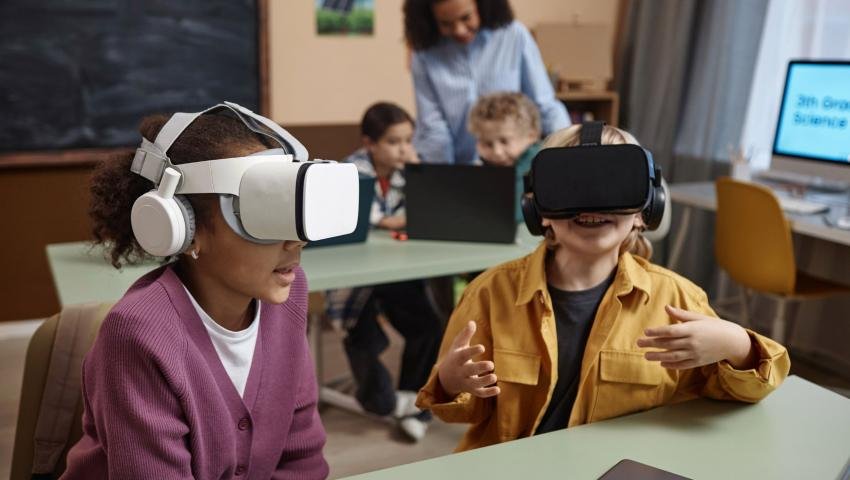
Leveling Up Reality: Inside the World of AR & VR Game Creation
AR (Augmented Reality) and VR (Virtual Reality) games aren’t just games—they’re full-on experiences. They blur the line between the digital and the real world in ways that regular screen-based games just can’t.AR and VR game development is all about creating immersive, interactive worlds.
Leveling Up Reality: Inside the World of AR & VR Game Creation
Let’s get one thing straight: AR and VR games aren’t just about slapping a headset on and waving your hands around like a confused robot. They’re immersive experiences — built with purpose, complexity, and a whole lot of coffee.
From Pokémon Go to Half-Life: Alyx, we’ve seen glimpses of what’s possible when digital worlds collide with our reality. But behind the magic lies a seriously intricate development process.
The Magic Starts with the Right Question
Before writing a single line of code, game developers ask: “What’s the experience supposed to feel like?” In AR (Augmented Reality), you are layering digital objects over the real world. In VR (Virtual Reality), you’re fully transporting someone somewhere else.
That means designing for space, movement, and senses , not just screens.
Do you want the player to feel wonder? Fear? Total immersion? That goal drives every design choice — from environment creation to interface placement.
AR Games: Blending Digital with Physical
Making AR games is this weird mix of coding and knowing how stuff works in the real world around you. You need to:
- Work with real-world maps and GPS data (hi, Unity + ARKit/ARCore)
- Calibrate for different lighting, surfaces, and environments
- Keep your app lightweight enough to not fry someone’s phone
Oh, and design for walking — because nobody plays AR games standing still.
VR Games: Creating Worlds from Thin Air
Building in VR is like mixing movie-making, designing buildings, and creating games — all at once. You're building entire 3D spaces — with believable physics, intuitive movement, and real-time interaction.
Key challenges include:
- Making movement natural (without motion sickness)
- Designing hands and gestures that feel right
- Optimizing performance so your GPU doesn’t cry
Tools like Unreal Engine and Unity are staples here. But unlike traditional games, you’re not just scripting gameplay — you’re shaping the entire world the player lives in.
Interaction Is Everything
Forget menus. In immersive games, you’re interacting through gestures, eye movement, head turns, and even voice. That means traditional UI/UX thinking goes out the window.
- Is that button too far to reach?
- Will this object feel natural when picked up?
- Can users feel what they’re doing?
These questions are as important as story or graphics.
Hardware: A Moving Target
AR/VR tech is evolving fast . What works on a Meta Quest 3 might not run on older gear. Developers constantly chase optimization across:
- Headsets (Oculus, HTC Vive, PSVR, Apple Vision Pro)
- Mobile AR (iOS, Android)
- Motion controllers, haptics, and even body tracking suits
The best devs design modular systems — so as new gear drops, the game doesn’t break.
Testing in Immersion: A Developer’s Workout
QA for AR/VR isn’t just bug hunting — it’s literally wearing the device and walking through the experience over and over. You’re checking:
- Frame rate consistency
- User comfort
- Real-world interference (sunlight, obstacles)
Imagine playtesting for 6 hours inside a headset. Your neck gets a workout.
The Future: Social, Scalable, Surreal
AR/VR gaming is headed toward shared experiences — think multiplayer AR quests or VR party games in massive worlds. And as devices get cheaper and lighter, we’ll see:
- More indie innovation
- Cross-platform AR/VR integration
- Games that blend real-time AI, physics, and player emotion
Picture playing AR game that changes based on how you're feeling — like it knows when you're excited or bored. Or a VR game that shifts the story based on your gaze. That’s the future — and it’s coming fast.
Final Thoughts
Making AR and VR games isn’t exactly a walk in the park — it’s tough, weird, and seriously not for the faint-hearted. It’s part art, part engineering, part sci-fi dream. But for those who love the idea of literally creating new realities — it’s one of the most exciting frontiers out there.
You’re not just building games. You’re building experiences . Ones people step into, remember, and come back to.
Welcome to the future of gaming.
Rukhsar Jutt
Leave a comment
Your email address will not be published. Required fields are marked *

